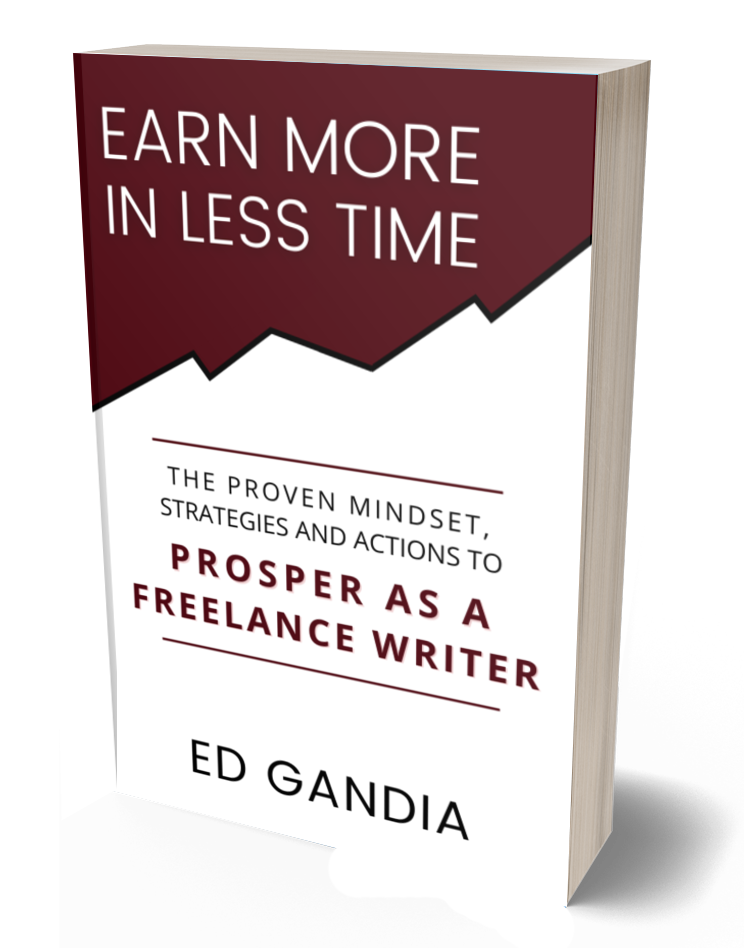Hey, there. Welcome to another episode of the High-Income Business Writing podcast—the #1 podcast for freelance writers, copywriters, and solo marketers who want to earn more in less time… doing work they love… for better clients. With over 1.3 million downloads from listeners just like you across 101 countries.
You know it’s supposed to help you grow your freelance business. But the idea of reaching out to prospects and clients just to “stay in touch” or to “follow up” starts to feel awkward fast.
You don’t want to annoy people. Yet it often feels like all you’re doing is circling back to ask, “Are you ready to hire me yet?” … which starts to feel a little desperate and kind of pointless.
But what if there were a better way to build real connections — one that didn’t feel like a game of endless follow-ups or forced small talk? In this week’s episode, I’m joined by Melissa Mitri, a successful freelance health writer and content strategist who’s built a thriving business without relying on traditional networking tactics.
Melissa shares her refreshingly authentic approach to connecting with editors and brands. Her approach focuses on empathy, generosity, and strategic follow-ups instead of the same, old, boring approaches to follow-up. And you’ll walk away with simple, practical ideas you can implement right away.
We talk about:
- Redefining networking on your own terms (yes, even if you’re shy!)
- How Melissa stays top-of-mind with clients without being pushy
- Low-stress ways to add value and build trust before landing a gig
- Simple follow-up tactics that don’t feel annoying or salesy
If you’ve ever wondered how to build real relationships with clients in a way that feels good, you’re going to love Melissa’s insights.
The notes that follow are a very basic, unedited summary of the show. There’s a lot more detail in the audio version. You can listen to the show using the audio player below. Or you can subscribe on Apple Podcasts, Spotify, Stitcher, Google Podcasts, Amazon Music or wherever you listen to podcasts.


High-Income Business Writing with Ed Gandia
#370: How to Stay Top-of-Mind without Being Annoying — Melissa Mitri’s Low-Stress Approach to Nurturing Client and Prospect Relationships
Key Topics and Bullets:
- Effects of market changes and layoffs on industry
- AI’s impact and the need for expert reviews
- Melissa’s definition of networking
- Natural connection strategies
- Connecting via LinkedIn and commenting on posts
- Tracking connections and ensuring regular follow-ups
- Staying in touch with clients regularly
- Offering additional services and ideas
- Addressing market challenges editors face
- Approaching clients with a service-oriented mindset
- Building relationships confidently
- Benefits of relationship-building during busy times
- Simplified strategies for networking
- Final encouragement to connect naturally
- Mentoring opportunities for writers
Timestamp Overview:
00:00 Ed– This is gonna be a really fun conversation. I think it will be very fruitful for a lot of people. We’re gonna get into some unique ways to build relationships, that I think is gonna resonate with a lot of listeners. Before we do that, I always like to ask guests to let us know a little bit more about what they do, what kind of clients they work with, what kind of projects they work on, just so people have a little bit of context so they know where you’re coming from.
Melissa – Sure. So I am a freelance writer and also a registered dietitian nutritionist by trade. So I’ve been a dietitian for a little over eighteen years, and also work as a freelance writer for mainly health and wellness outlets and brands. And so I work with a variety of clients, in terms of writing. A few major media outlets like Everyday Health or Eat This, Not That. So kind of those larger publications. But I also work with several health and wellness brands, supplement brands, mostly.
04:51 Ed– what are you, what are you seeing? Because, obviously, the journalism work, you know, as a whole, right, has been on the decline because publications are suffering. And, you know, I know that some are doing well, and many of them have moved online, done away with print entirely. But, where are you, what pockets are you seeing that are growing? Like, I’m particularly intrigued by, you know, those applications that you mentioned. And, you know, I never thought about, gosh, there’s opportunities there for writers too, not just in terms of, you know, the writing that’s involved there, but also the messages, the instructions, etcetera. So where are you seeing some of the growth in that market for someone like yourself?
Melissa– So definitely some changes have been happening. As you said, one of them being that the shifts sort of in the economy and the market with a lot of editors being laid off are sort of restructuring for those big major outlets. And so that’s that for that piece, it kind of resulted in more of the editors kind of having to do some of the writing themselves or having less writers overall. But then, in turn, that’s also opened up more opportunities for writers to do more of the article reviews like I’m doing. So there’s a few of the outlets that I previously wrote for or just solely wrote for. Now I’m providing more of those medical reviews, but in a higher volume. And so, the rate for that is still pretty good, and, it’s very flexible work, work that I say that doesn’t require quite as much concentration that I could almost do when my kids are right there next to me, which is super helpful at times.
06:48 Ed– Well, tell me a little bit about this idea of building a business, a solo business, without necessarily having to cold pitch all the time or having to do traditional networking. Because I know that you do quite a bit of networking, but it’s different. Right? So why don’t we establish that definition? What does networking mean to you?
Melissa– It’s a great question. So I think a lot of times when we may think about networking, traditionally, we may think of, you know, that being a little bit intimidating or scary, especially for a lot of us freelance writers that, you know, maybe you’d be used to working from home, kind of in a solo environment. And so networking can mean a lot of different things. To me, personally, it really means just connecting with others in whatever way feels most natural to you. And so I think that’s really the key is thinking about yourself and, you know, even in terms of when you’re thinking about how when you’re, you know, you have a preferred platform that you’d like to post on on social media, for example, if your preferred way of communication, you really networking can mean it doesn’t have to be going to a large conference or being around a lot of people, but it can mean just having a coffee chat with somebody on Zoom. It can mean just sending a message saying hello to a potential prospect on LinkedIn. So it’s really just kind of connecting with people and first, kinda taking that step back and taking the sales side out of it so that you don’t feel that pressure.
11:41 Ed-Tell me a little bit about how you think about this in terms of your, your connections, the connections you make. So you mentioned one of them is, let’s say, you’re on LinkedIn, and it sounds like, you know, that you’re constantly on the lookout for interesting posts that you can maybe comment on or like or share. But I’m trying to kinda get an idea of how you approach it. You know? If you were to deconstruct your MO, what does that look like if you were to turn it into an actual written recipe? And I know that’s maybe that’s not how you do it. You do it in a very organic way. But for somebody who kinda wants more practical advice, what would you say? What would you tell them they focus on and and and be on the lookout for?
Melissa– So I’d say first, so if you know, as a number one starting point, is think about those, you know, a handful of people that you like to connect with. So first, you know, establishing that connection and connecting with them on LinkedIn, if that’s possible. If not, you know, you could be following them and, you know, starting with building a connection by commenting on their post, as you said. So really responding though in a sort of genuine way, where you’re sharing your thoughts that are you know, in in sharing your thoughts, you’re sort of, you know, sharing your expertise without being, again, overly sales y, but you’re showing them that you know your stuff and that you’re, you know, if you do that several times, they’ll start to see your name more often. And so it could be either commenting as a starting point commenting on their post or just sending them a genuine message, with your comments. If you wanna be a little bit more direct and send them you know, get into their inbox and send them a genuine message. So depending on the client and the type of writing work you do, you may just offer them, like, a genuine compliment.
14:10 Ed-So that’s kind of the initial touch point. How do you then stay top of mind? Right? Because I can see, like, if I started doing this much more deliberately after about three months, I’m gonna lose track of who I’ve been reaching out to, connecting, liking, commenting. So or emailing. How do you track this? Or do you track it? How do you stay top of mind with folks?
Melissa– So I definitely do track it, and I think I would definitely recommend doing that if you’re contacting more than a handful of people prospects at any given time. So I started out using an Excel spreadsheet and keeping it super simple with the technology, but then over time now, I use more of a, you know, a program like ClickUp. ClickUp, I really like because I find it simple to use where you can set reminders to check back in with people and kind of have a flow to that. So I would definitely recommend at the very basic level just starting, a running list of, of prospects and, you know, include when you last reach out to them, what you said or the gist of what you said to them, if they responded, and then when you’re following up again. And so you can kind of set a cadence of, you know, checking back once a week. For example, not necessarily that you have to check-in with everyone every week, but, setting a cadence of at least looking back at that list and kind of building it and, you know, so that you remain top of mind and you don’t go too long, without reaching back out to them. I think that one of the biggest things that’s really important is staying in touch with prospects and with clients, current clients, even when you aren’t getting work from them, especially when you aren’t getting work.
19:15 Ed– What else are some other things that you have in your toolbox so it doesn’t always feel like the same thing over and over again?
Melissa– So I think that, you know, depending on the situation, if you’ve, you know, established that initial connection and you are, either hearing back or, you know, whether they they get back to you and maybe they don’t have the writing work right now or maybe they didn’t get it back to you yet, you know, you I think another another avenue you can try if you’re open to this is, you know, also offering other other services or even a quick tip for them. So you mentioned that you know, you mentioned the pitching the story idea depending on, you know, who you’re pitching to. But for a brand specifically, you know, that could be the case as well. But you can also, you know, mention something that you saw on their website, and then you might think of a specific topic that they might need or a specific avenue that they haven’t approached, you know, maybe updating content, if you see that some of their content is outdated. Or you could offer other services in addition to writing if they say that they don’t need, they have enough writers right now. You can offer to do reviews.
20:12 Melissa-You can fact check articles. You can update content, or you can provide your expertise for special projects. So if they have, you know, if they know there’s other ways they can utilize your services, again, if you’re open to this, I think that’s always helpful to try to, you know, kind of vary your income sources as much as possible. Especially if you’re in a lull with writing work too, kind of expand on some of the skills that you may have because even for content marketing, there’s a lot of different types of writing that you can do, even if it’s not just specifically articles. Like you mentioned, you can suggest white papers. Or if it’s a company that has a product, you know, you can, you can do a review of their product on their website or on your own website, or there’s so many different things that you can pitch. I often like using chat deep GPT if I’m looking for ideas, a lot of times too, just to kind of flush out some thoughts that are already in my head. So kind of utilizing what you already know about the brand, and some ideas that are floating through your head and kind of prompt the AI tool to think of some other avenues for you.
24:07 Ed– I know you had mentioned to me that, you know, because you do work with several publications and we’re in a market where editors are being, you know, laid off, budgets are being cut left and right. I’m curious what role does empathy play in your approach. Right? Because many times, you never know where that person’s going to be, you know, what’s going on in their world. So how do you navigate those waters?
Melissa– Great question. So it’s always important to approach your communication in a way that takes them into account. Right? So if you don’t, you know, as you mentioned, especially now over the past several months, there’s been a lot of changes in the market. And, oftentimes, we don’t really know what’s happening until we hear about it after the fact. And so I know I’ve had personally a few of my editors that got laid off, and they, you know, they didn’t let us know, like, the day of. And sometimes they weren’t even aware of it.
27:18 Ed-So a lot of people ask me, well, what’s the point of doing any of this when I’m slammed? And, you know, I can’t take on any more work. And I say, actually, there’s some very good reasons why that’s when you should do it. Number one is that I bet you’re not. I call it nurturing, nurturing your relationships. I bet you’re not nurturing your relationships when you need work because you’re not nurturing. At that point, you’re prospecting and you’re pitching. Number two, so now you don’t need work, so just shift your effort from prospecting to nurturing because you haven’t been doing it, number one. Number two, you’re gonna quickly discover that you’re gonna be the most effective at it at that point because you’re coming at it with a totally different energy. You’re there to, like you said, from a you’re coming to it from a place of service rather than from a place of desperation or from need. It doesn’t have to be desperation. So what I would do is I would encourage everyone to, even when you’re slammed, when you’re booked solid, you really should make it a point to continue your nurturing because that’s when you’re gonna be the most effective. And that’s when you’re planting seeds for the time. Could be a month or two months from now when you actually do need more work. And you haven’t been making those you know, some people call it deposits into the relationship bank accounts. If you haven’t been making the deposits, you’re gonna be overdrawn when you do need to make withdrawals.
34:53 Ed– As we close, I’m curious what if you had to pick one simple relatively low stress action that a listener could take this week to actually start building and strengthening their relationships with editors, with past and current clients, with dead leads. What might that be? Because you’ve offered some great ideas, and sometimes, you know, a list of great ideas is wonderful, but there’s no clear starting point. So what would be a really easy way to get started?
Melissa– So I think so in terms of for prospects, so for potential clients or editors you want to connect with, I would say just start with just pick five five potential clients that you wanna connect with and send them a message or comment on one of their posts. So just connect with them on LinkedIn, engage with them, again, before you ask for anything in return and just start that initial conversation with them. That’s something really simple that only takes a few minutes to do, and it can get you over that hump of just getting into the process of that consistent prospecting. And then for current clients or clients that you really haven’t heard from in a while, I think just send them a check-in message. Just put checking in the subject line and, you know, just let them know that you’re, you know, checking in with them, asking how they’re doing. Right? Because again, this is the, this is the human touch of, you know, we’re not just asking for work, but we’re asking the person, you know, really, how are they doing? You hope they’re doing well and just checking in to see if, you know, you need any help with anything. And then that could be that initial conversation where you build from there.
By the way… whenever you’re ready, here are 4 ways I can help you grow your freelance business:
1. Claim your free book:
Discover the secrets to a thriving writing career in Earn More in Less Time: The Proven Mindset, Strategies and Actions to Prosper as a Freelance Writer. — Download your FREE copy
2. Level up with the ultimate business-building toolkit
Ready to fast-track your freelance success? My comprehensive Business-Building Toolkit equips you with the essential skills to command higher fees, win premium clients, blend AI into your workflow, and build more predictable freelance income. Developed from years of coaching top freelancers, this toolkit is your roadmap to rapid results. — Learn More?
3. Work with me for 90 days
Need a trusted “sparring” partner to tackle your most pressing business challenges? I occasionally offer an intensive 90-day coaching program for freelancers at all income levels. We work together 1-on-1 to identify your most critical business obstacles, come up with innovative solutions and develop a customized, actionable plan. Email me at ed@b2blauncher.com with “90-Day Accelerator” in the subject line to learn more.
4. Banish 6-figure burnout
One of my core specialties is helping 6-figure freelancers earn more in less time with less stress. If you’re at that income level but you’re burning out and want to create a business that actually serves you, let’s connect. Email me at ed@b2blauncher.com and put “Boardroom” in the subject line and I’ll get back to you with more details.






